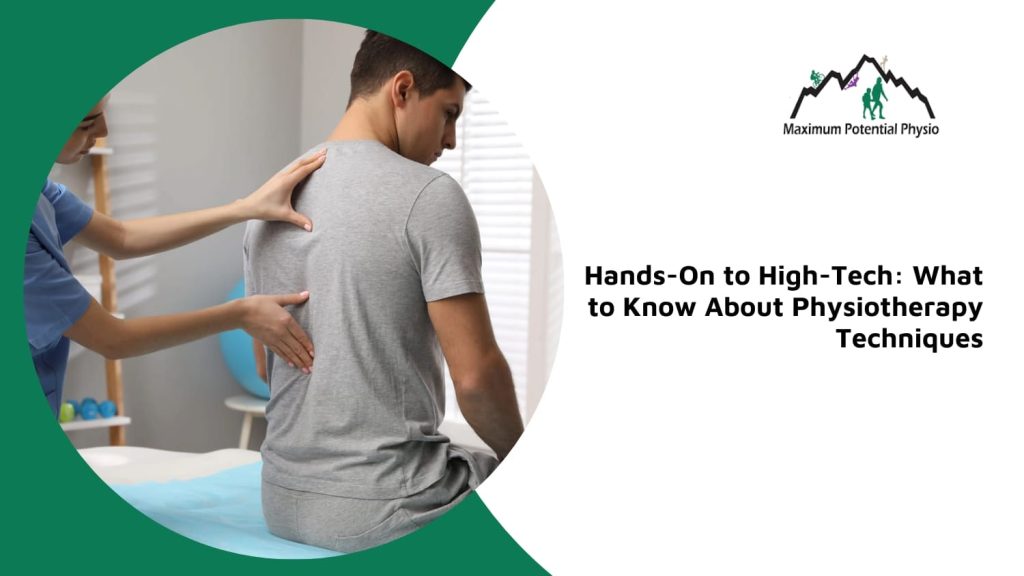Hands-On to High-Tech: What to Know About Physiotherapy Techniques

Physiotherapy is a highly adaptable field that combines movement science, manual techniques, and evidence-based care to help individuals recover from injury, manage chronic pain, and restore physical function. What makes physiotherapy especially effective is the wide variety of techniques used—each selected based on your body’s condition, recovery stage, and goals. In this blog, we’ll explore the most common physiotherapy techniques, how they work, and the role each plays in supporting recovery, mobility, and long-term well-being.
Most Commonly Used Physiotherapy Techniques
Physiotherapists use a variety of techniques to address pain, improve mobility, and restore function. Some of the most commonly used methods in rehabilitation include:
- Manual Therapy: Hands-on techniques to mobilize joints, release tight muscles, and improve tissue flexibility.
- Exercise Therapy: Targeted movements to strengthen muscles, improve flexibility, and support functional recovery.
- Electrotherapy: Use of electrical currents to stimulate nerves, relieve pain, and promote healing.
- Soft Tissue Release: Techniques focused on breaking up adhesions and improving circulation in muscles and fascia.
- Dry Needling: Insertion of fine needles into trigger points to reduce muscle tension and pain.
- Ultrasound Therapy: Application of sound waves to promote tissue healing and reduce inflammation.
- Shockwave Therapy: High-energy sound waves used to treat chronic conditions by stimulating tissue repair.
These techniques are often combined to create a comprehensive, personalized treatment plan that adapts over time.
The Role of Manual Therapy Techniques in Physiotherapy
Manual therapy is a cornerstone of many physiotherapy treatment plans, especially in the early stages of rehabilitation. It involves hands-on techniques that aim to reduce pain, increase range of motion, and improve tissue mobility. Common approaches include:
- Joint Mobilization: Gentle oscillatory movements applied to a joint to improve mobility and reduce stiffness.
- Soft Tissue Mobilization: Massage-like techniques used to release muscle tension and promote circulation.
- Myofascial Release: Slow, sustained pressure applied to connective tissues to break down adhesions and restore movement.
- Passive Stretching: Therapist-guided stretches to improve flexibility and reduce muscle tightness.
Manual therapy is particularly effective for conditions involving joint stiffness, muscle spasms, or postural imbalances.
How Exercise Therapy Fits Into Physiotherapy Treatment Plans
Exercise therapy is central to most physiotherapy programs, focusing on restoring strength, flexibility, balance, and endurance. These exercises are carefully tailored to each individual’s condition and may include:
- Range of Motion Exercises: Improve joint flexibility and prevent stiffness.
- Strengthening Exercises: Target weak muscle groups to restore stability and function.
- Balance and Coordination Drills: Enhance proprioception and prevent falls, especially important for seniors.
- Functional Training: Mimics everyday activities to help people regain independence in daily tasks.
- Postural Correction Exercises: Address muscle imbalances and support better body mechanics.
Exercise therapy not only aids in recovery but also plays a preventive role, reducing the risk of re-injury and promoting long-term health.
Passive and Active Physiotherapy Techniques: What’s the Difference?
Physiotherapy uses both passive and active techniques to support recovery, each serving a different purpose within the treatment process. Passive techniques are applied by the physiotherapist without requiring the client to perform any movement. These include methods such as manual therapy, ultrasound, electrotherapy, and taping, and are often used at the beginning of a treatment plan to reduce pain, swelling, or stiffness.
In contrast, active techniques involve the client’s direct participation. These may include exercises that improve strength, flexibility, balance, or coordination, and are typically introduced as pain subsides and mobility improves. Active methods not only promote physical recovery but also encourage long-term independence by helping people rebuild function. A balanced physiotherapy plan often starts with passive techniques to manage symptoms and then progresses to active techniques that address the root causes of dysfunction, supporting a more sustainable recovery.
How Soft Tissue Release Techniques Support Recovery
Soft tissue release techniques are used to address restrictions in muscles, tendons, ligaments, and fascia. These methods help restore normal movement patterns, reduce pain, and promote healing. Common techniques include:
- Trigger Point Therapy: Targets specific knots or “trigger points” that refer pain to other areas.
- Deep Tissue Massage: Applies firm pressure to break down scar tissue and adhesions.
- Cross-Friction Massage: Used to realign muscle fibres and promote healing in chronic injuries.
These techniques are especially beneficial in treating sports injuries, repetitive strain injuries, and postural issues.
Physiotherapy for Chronic Pain: How Shockwave Therapy Helps
Shockwave therapy is a non-invasive technique that delivers high-energy sound waves to injured tissues. It is particularly effective for chronic musculoskeletal conditions that haven’t responded to other treatments. Benefits include:
- Stimulating Healing: Promotes collagen production and increases blood flow.
- Breaking Down Calcifications: Useful for conditions like calcific tendinitis.
- Pain Reduction: Interferes with nerve activity to reduce pain perception.
- Restoring Mobility: Helps resolve long-standing inflammation and tissue stiffness.
Shockwave therapy is commonly used for plantar fasciitis, tennis elbow, Achilles tendinopathy, and shoulder calcifications.
How Physiotherapists Choose Which Techniques to Use
Physiotherapists assess an individual’s condition, medical history, lifestyle, and treatment goals before selecting appropriate techniques. The choice of methods depends on several key factors:
- Type and Severity of Injury: Acute injuries may require pain relief and swelling reduction, while chronic issues may focus on strengthening and mobility.
- Individual Goals: Whether the aim is to return to sport, improve daily function, or reduce chronic pain, the plan is aligned accordingly.
- Age and Physical Condition: Techniques are adapted based on the person’s age, physical capacity, and any coexisting conditions.
- Tissue Involvement: Different approaches are used depending on whether the issue is muscular, joint-related, neurological, or connective tissue-based.
- Response to Treatment: Plans are adjusted over time based on how the person responds to therapy.
Each treatment plan is individualized, ensuring that techniques are both effective and safe.
Are Physiotherapy Techniques Safe for All Age Groups and Conditions?
Physiotherapy techniques are generally safe for individuals across all age groups, from young children to older adults, when performed by a qualified professional. Before beginning any treatment, physiotherapists conduct detailed assessments that take into account a person’s medical history, current medications, and overall health profile. This allows them to identify any risks and adapt techniques accordingly. Treatment plans are customized and may begin with lower-intensity approaches, especially for those with more fragile health or chronic conditions. As the individual’s strength and mobility improve, techniques are gradually adjusted to match their progress.
Physiotherapists also monitor each session closely, making changes as needed to ensure ongoing safety and effectiveness. Whether the goal is to support developmental progress in children, rehabilitate an injury in an adult, or improve balance and function in a senior, physiotherapy is designed to be flexible and responsive. Its adaptability makes it a suitable and safe form of care for a wide range of physical conditions and stages of life.
How Mobility and Stretching Techniques Improve Joint Function
Mobility and stretching exercises play a vital role in restoring healthy joint movement. These techniques are designed to:
- Improve Range of Motion: Regular stretching helps lengthen muscles and tissues around the joint, allowing for smoother movement.
- Reduce Joint Stiffness: Dynamic and static stretches promote flexibility and reduce restrictions that limit function.
- Enhance Circulation: Movement encourages blood flow to muscles and joints, supporting tissue repair.
- Prepare the Body for Activity: Mobility work primes the joints and muscles for exercise or daily tasks, reducing the risk of strain.
- Support Postural Alignment: Improved mobility in key areas like the hips and shoulders helps maintain better overall posture.
Physiotherapists often include mobility drills early in a session to prepare the body for more targeted strength or coordination work.
Aquatic Therapy vs. Traditional Physiotherapy Methods
Aquatic therapy, or hydrotherapy, is conducted in a pool and offers a unique set of advantages not found in land-based physiotherapy. Key differences include:
- Reduced Weight Bearing: Water’s buoyancy lessens the load on joints and muscles, making movement easier and less painful.
- Natural Resistance: Water provides constant, even resistance that helps build strength and endurance.
- Improved Balance and Safety: The supportive nature of water allows people to practice balance and coordination with reduced fall risk.
- Enhanced Relaxation: Warm water helps soothe sore muscles and can promote overall relaxation.
Aquatic therapy is especially helpful for individuals with arthritis, post-operative limitations, or mobility challenges due to neurological conditions.
Techniques Tailored to Your Needs
Physiotherapy techniques offer a flexible and science-backed path to healing—combining movement, manual care, and modern tools to help people recover and stay active. Whether you're dealing with chronic pain, recovering from surgery, or trying to prevent future injury, understanding these techniques is the first step toward more confident movement.
At Maximum Potential Physiotherapy in Calgary NW, we tailor every treatment plan using the techniques best suited to your condition, needs, and recovery timeline. Book your appointment today and take the next step toward stronger, pain-free movement.

